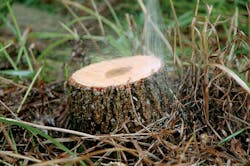Spring and foliar spraying season are right around the corner, but vegetation managers don’t have to wait on foliage to start treating problematic trees and incompatible brush species throughout utility rights-of-way and adjacent land. In fact, vegetation managers can get a head start on the year to come by using effective vegetation control methods from late winter to early spring. These dormant-season strategies allow utility companies and their contract partners to get more out of their labor force, increase program efficacy and significantly improve ROI.
Why Vegetation Managers Should Use Dormant-Season Herbicide Applications
Controlling incompatible brush and undesirable trees is essential to the success of utility vegetation management programs. Using selective herbicide applications as part of an Integrated Vegetation Management (IVM) program can help practitioners effectively control troublesome woody species throughout utility rights-of-way while enhancing the growth of native grasses and forbs that support wildlife habitat biodiversity.
Comparatively, nonselective control methods, such as mechanized mowing, control beneficial plant species as effectively as targeted vegetation. This increases maintenance requirements and associated costs over time.
Utility vegetation managers often use foliar herbicide applications to enhance results for their IVM programs throughout the growing season, but the option to use such methods is lost during fall leaf senescence. Fortunately, the following herbicide application methods can be used throughout the dormant season to help vegetation managers assert and maintain control of woody plants that threaten the integrity of utility infrastructure and the reliability of electrical service:
Dormant-stem treatment
- Recommended for brush up to 10 feet tall or 2 inches in diameter
- Treatments are applied to the stems and trunk of targeted plants
- To improve herbicide penetration, enhance coverage and optimize results, the use of basal oils is recommended
- Apply from fall leaf senescence until 25% plant leafout in the spring
- Popular product recommendation*: Tank mix featuring Garlon® 4 Ultra and TerraVue® herbicides from Corteva Agriscience
Basal bark treatment
- Best suited for areas with 500 stems per acre or less
- Recommended for individual stems no larger than 6 inches in diameter
- Treat the lower 12 to 15 inches of a targeted stem’s base using a selective herbicide mix and highly targeted application method
- Not to be used for environments where snow or water prevent spraying to the ground line
- Popular product recommendation*: Garlon® 4 Ultra herbicide from Corteva Agriscience
Basal cut-stump treatment
- Perfect for treating individually cut woody plants
- Apply a selective herbicide mixture to the cambium layer and any exposed bark or roots that remain
- Popular product recommendation*: Garlon® 4 Ultra herbicide
Why Vegetation Managers Should Care
Planned treatment cycles are often derailed by a variety of unforeseen factors, including weather delays and labor shortages. As brush species can grow up to 40% in a single year, research has shown that deferring maintenance by a single growing season can double the cost of vegetation maintenance in the future. This means that failing to control incompatible woody plants this year can lead to greater issues next year when targeted vegetation is larger and more costly to control.
In addition to enhancing productivity and cost efficiency, dormant-season treatments can provide the following benefits to utility vegetation managers from late fall to early spring:
- Dormant-season applications extend the treatment season, allowing vegetation managers to use late-season funding.
- Seasonal flexibility can maximize the use of a dedicated labor force, which enhances programmatic ROI.
- Controlling previously untreated vegetation in the fall allows vegetation management programs to get a jump-start on treatments that would be otherwise deferred to the following foliar season.
- Selective herbicide mixes can be used to support spring green-up for grass and other desirable plants that form a natural barrier against incompatible stem growth.
- Treated plants simply don’t leaf out in the spring following dormant-season treatments, which reduces brown-out (except on evergreens), public scrutiny and potential complaints.
To learn more about seasonal treatment opportunities, and best practices for improving land stewardship or environmental sustainability, explore the portfolio of industry-leading content archived at VMVistas.com.
*Check product label for state registrations, controlled species and recommended use rates.
™ ® Trademarks of Corteva Agriscience and its affiliated companies. Under normal field conditions, TerraVue® is nonvolatile. TerraVue has no grazing or haying restrictions for any class of livestock, including lactating dairy cows, horses (including lactating mares) and meat animals prior to slaughter. Label precautions apply to forage treated with TerraVue and to manure and urine from animals that have consumed treated forage. TerraVue is not registered for sale or use in all states. Contact your state pesticide regulatory agency to determine if a product is registered for sale or use in your state. Consult the label for full details. State restrictions on the sale and use of Garlon® 4 Ultra apply. Consult the label before purchase or use for full details. Always read and follow label directions. © 2023 Corteva.
Sponsored By:




